Enabling user registration on your WordPress site can open up a wide range of possibilities, like building a membership community, allowing guest posts, adding comments, and more.
By allowing users to register, you can boost engagement, streamline content management, and create a more interactive experience for your audience.
In this article, we will show you how to easily allow user registration on your WordPress site and how to manage users. Our clear, step-by-step instructions will be user-friendly. This way, you can easily follow along even if you are new to WordPress.
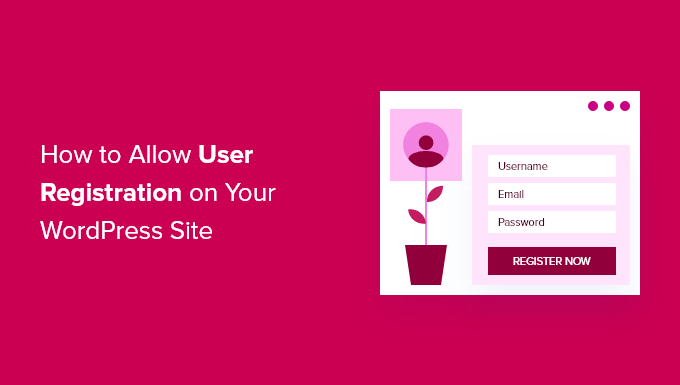
Why Allow User Registration in WordPress?
Adding a user registration form on your WordPress website can allow users to interact with each other and even build a community around your brand.
Plus, you can accept and post user-generated content on your WordPress blog, like posts, comments, images, videos, and more.
If you have an online store, then you can increase engagement by offering exclusive content or discount offers to customers who are registered on your site.
This can help improve user engagement, increase loyalty, and even help you build an email list by letting you collect email addresses during the registration process.
That being said, let’s see how to easily allow user registration in WordPress.
Here is the list of topics we will cover in this tutorial. You can use the quick links below to jump to different sections:
Note: This guide focuses on adding users to your WordPress site with default user roles and capabilities. If you are looking to make money online by allowing users to pay for premium content and access to a community, then you should see our ultimate guide to creating a WordPress membership site instead.
Enabling User Registration in WordPress
WordPress comes with built-in functionality to manage user registrations. It is turned off by default, but you can easily turn it on.
To do this, simply head over to the Settings » General page in your WordPress admin area.
From here, scroll down to the ‘Membership’ section and check the box next to the ‘Anyone can register‘ option.
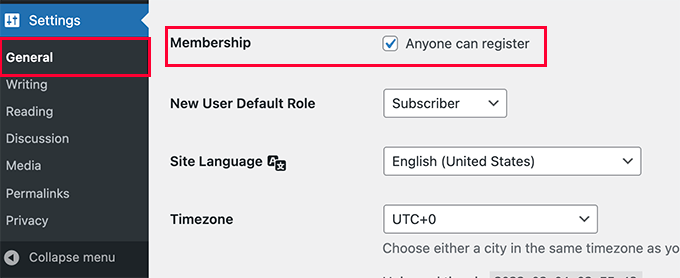
Next, you have to select the default user role. This is the user role assigned to each new user who registers on your WordPress website.
Each user role in WordPress comes with its own permissions and capabilities. See our guide on WordPress user roles and permissions to learn more about user roles in WordPress.
The default user role is ‘Subscriber’, which you can change to any other user role available.
For example, if you want users to write posts on your website, then you can change the default user role to Contributor or Author.
Important: Never use ‘Administrator’ as the default user role for user registrations, or a new user may be able to take over your website and lock you out.
Don’t forget to click on the ‘Save Changes’ button to store your settings.
Now, your WordPress site is open to user registrations. You can visit your WordPress login page, and you will see an option to register as a new user.
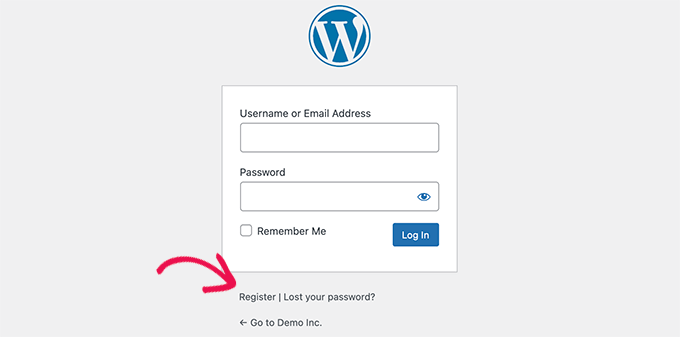
Adding Login and Register Links in WordPress
After opening your website for user registration, you will want to let users know that they can sign up and log in to their accounts.
There are multiple ways to do that.
You can simply add links in your WordPress sidebar to your login and registration page, or you can create custom login and registration pages for your website.
We will show you 3 different methods so you can choose the one that best suits your needs.
Method 1: Adding the Meta Widget to the WordPress Sidebar
The simplest way to add a login link is by adding the meta widget to your sidebar.
Simply go to the Appearance » Widgets page and add the ‘Meta’ widget to a sidebar. You can see our guide on how to add and use widgets in WordPress for detailed instructions.
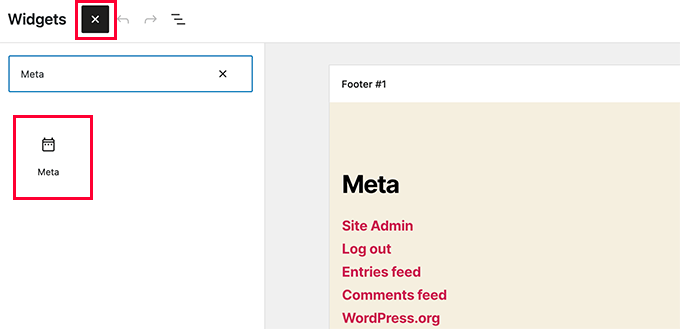
The meta widget includes links to register, login / log out, RSS feed, comments feed, and WordPress.org website.
This is how it appears on our example website:
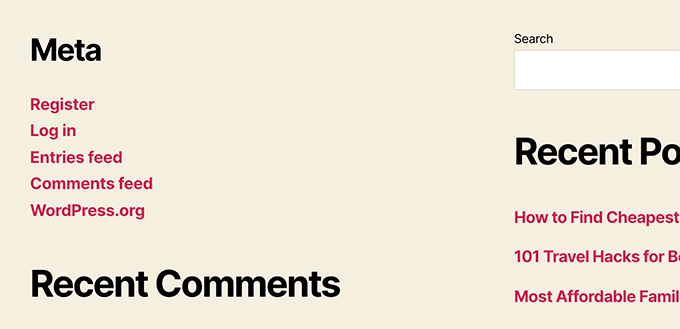
Keep in mind that if you are using a block theme, then the Appearance » Widgets option won’t be available for you. In that case, you can use methods 2 or 3.
Method 2: Creating Custom Login Pages Using WPForms
The problem with the first method is that there is no way to customize the registration or login forms. You can’t add form fields or change the design of the forms, and they won’t match the design of your website.
By using your own custom login pages, you can offer a much better user experience. You can embed your forms on any page on your website and add form fields to collect any information you want.
We will show you different ways to create your own custom login pages. The easiest one is to use the WPForms plugin.
It is the best WordPress contact form plugin on the market that comes with a user registration addon. It allows you to easily add and customize login and registration forms anywhere on your website.
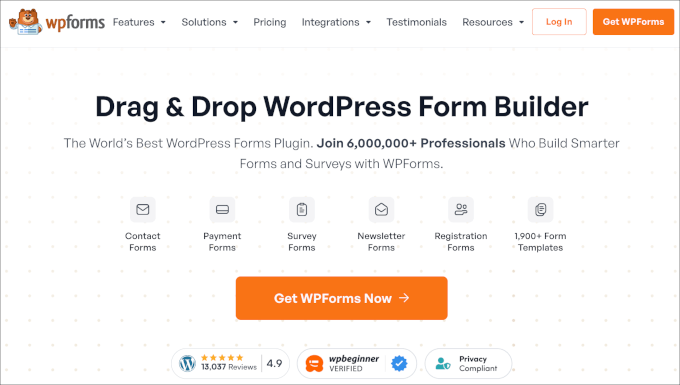
First, you need to install and activate the WPForms plugin. For more details, see our step-by-step guide on how to install a WordPress plugin.
Note: WPForms also has a free version. However, you will need at least the Pro license of the plugin to access the user registration addon.
Upon activation, visit the WPForms » Settings page to enter your license key.
You can find this information from your account on the WPForms website.
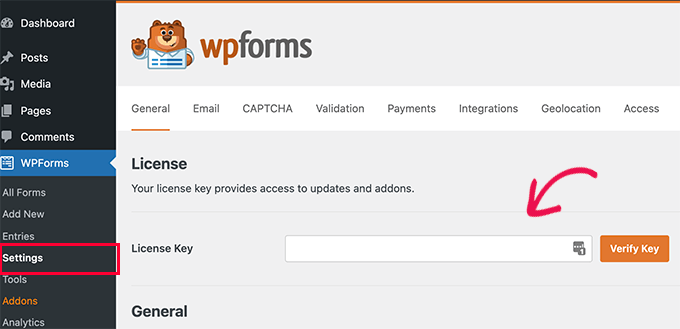
After verification, head over to the WPForms » Addons page from the WordPress dashboard.
Here, scroll down to ‘User Registration Addon’ and click on the ‘Install Addon’ button next to it.
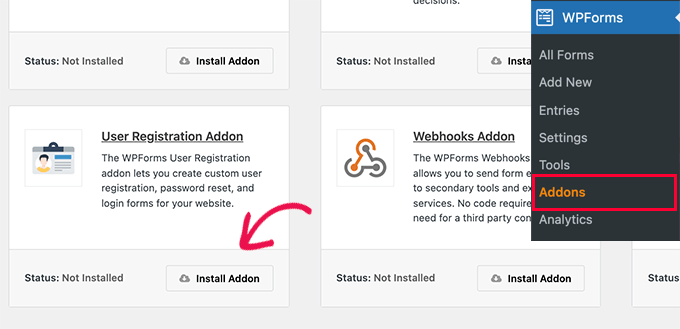
WPForms will install the addon, and then you will need to click on the ‘Activate’ button to start using it.
You are now ready to create custom registration and login forms using WPForms.
Creating a Custom Registration Form
Simply visit the WPForms » Add New page to launch the WPForms form builder.
First, you need to enter a form name and then search for the user registration template under the ‘Select a Template’ section.
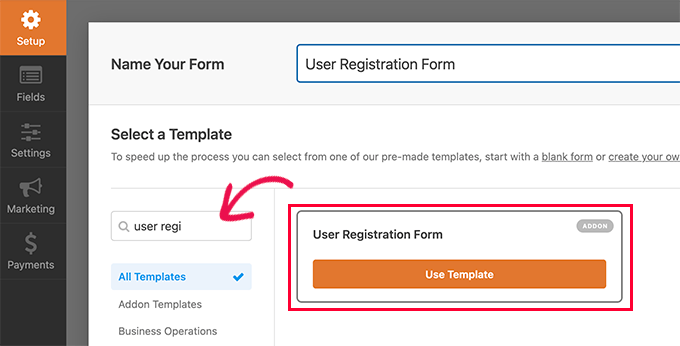
Once you’ve done that, click on the ‘Use Template’ button to continue, and WPForms will create a simple WordPress user registration form for you.
You can now add new fields from the left panel as well as customize the order of existing fields by using a simple drag-and-drop interface.
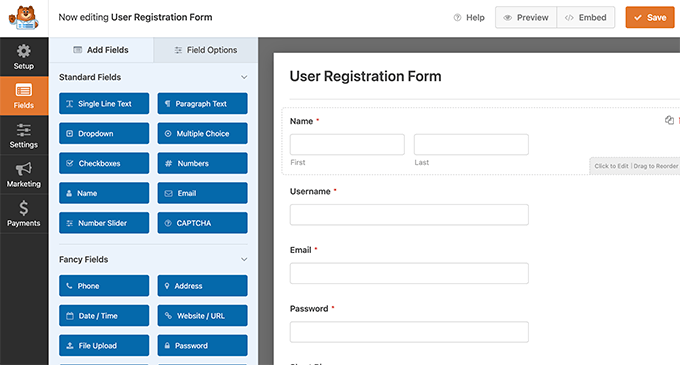
Once you are done adding the fields, click on the ‘Settings’ menu on the left.
Then select the ‘User Registration’ tab.
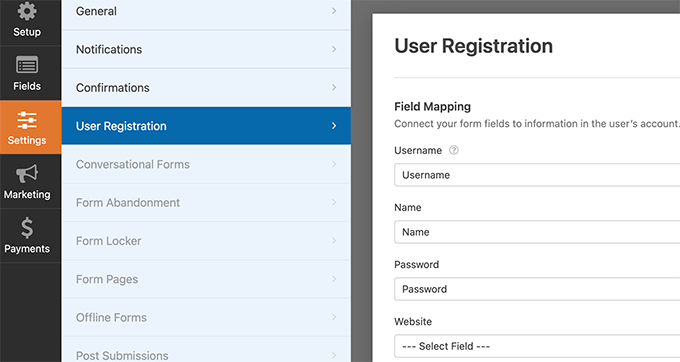
Here, you can map each form field to information in the user’s profile, select the user role, enable notifications, select the confirmation page, and enable user activation.
The user activation feature helps you reduce spam user registration in WordPress.
If you select the manual method, then all users must be approved by an admin before they can log in to your site.
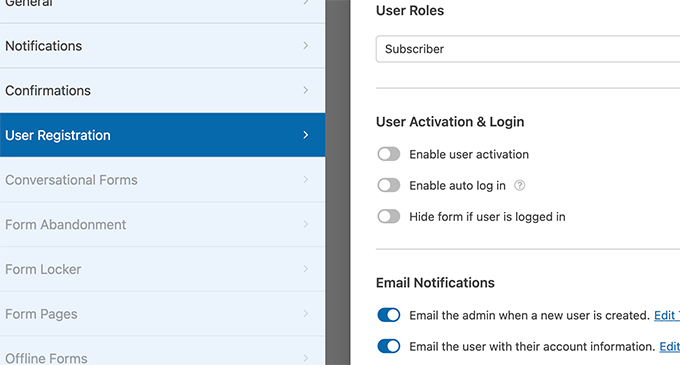
If you select the email method, then the user must click on an activation link before they can log in to your website.
Besides adding form fields, you can also connect your form with other WPForms addons.
For instance, you can connect to your email marketing service provider and automatically add new users to your email list. Similarly, you can connect WPForms to payment services like PayPal and Stripe to receive online payments.
When you are finished, don’t forget to click on the ‘Save’ button in the top right corner of the screen to save your form settings. You can now exit the form builder by clicking on the ‘Close’ button.
Your user registration form is ready to be added to your WordPress site.
Simply create a new WordPress page or edit an existing page that you would like to use as the registration page.
On the page edit screen, you need to add WPForms blocks to your content area.
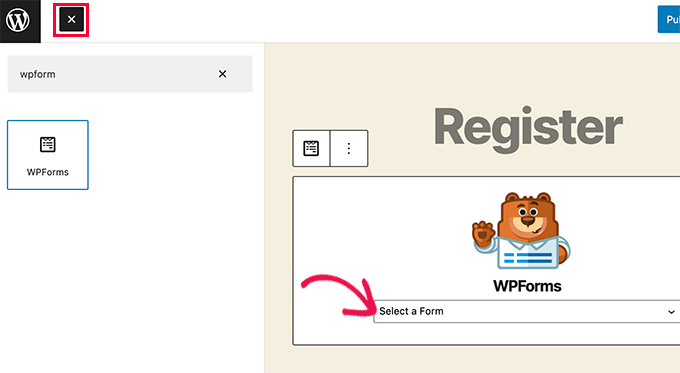
From the WPForms block, simply click on the dropdown menu and select the ‘User registration form’ you created earlier.
You can now save or publish your page and then visit it to see your custom user registration page in action.
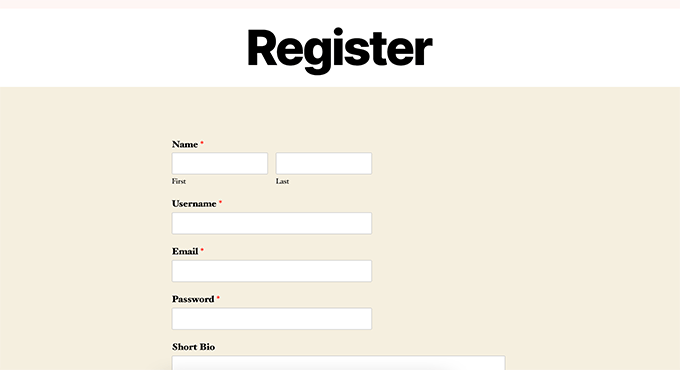
Creating a Custom Login Form
Now that your custom user registration page is active, you can also create a custom login form for your site with WPForms, making it the best WordPress user registration plugin on the market.
To get started, visit the WPForms » Add New screen. This will launch the form builder interface of WPForms.
You need to provide a name for your custom login form and then select ‘User Login Form’ as your template.
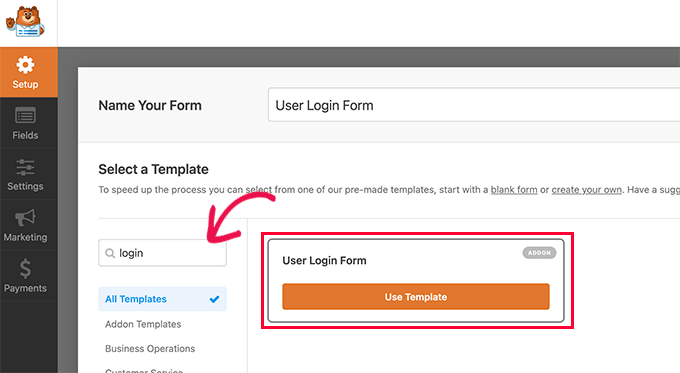
WPForms will now create a new login form.
By default, it only has the username and password fields.
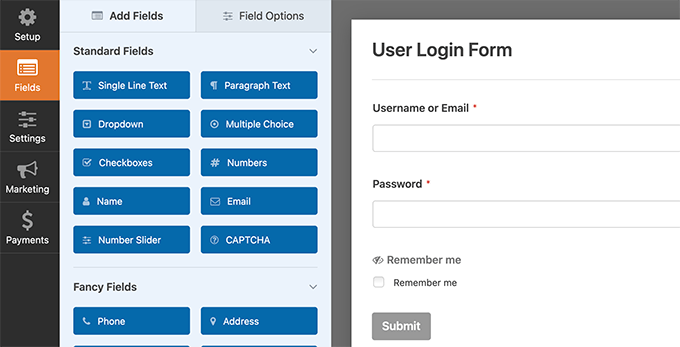
However, you can also add additional fields to the form by dragging them from the left panel.
Next, click on the ‘Settings’ tab and then click on the ‘Confirmation’ tab. This is where you can define what to do after a successful login.
You can show users a message, redirect them to the page they came from, or redirect them to any other page on your site.
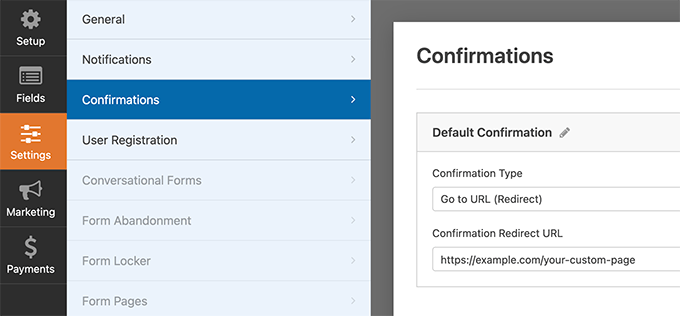
Click on the ‘Save’ button in the top right corner of the screen to store your form settings. You can now exit the form builder interface by clicking on the ‘Close’ button.
Your custom login form is ready to be added to your WordPress site.
You can add your custom login form to a page by creating a new page and then adding the WPForms block to the content area.
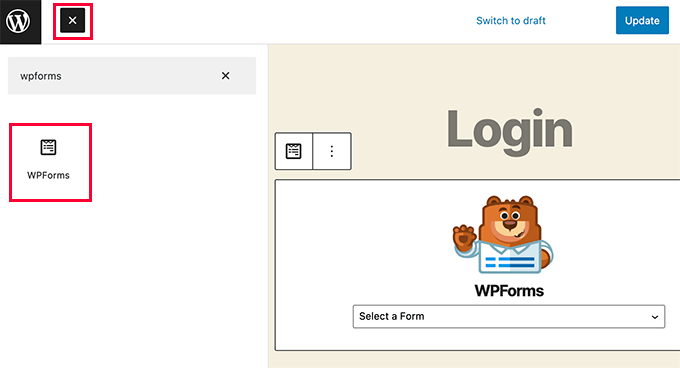
You can also add your custom login form to a sidebar.
Simply head over to the Appearance » Widgets page and add the WPForms block or the legacy widget to a sidebar.
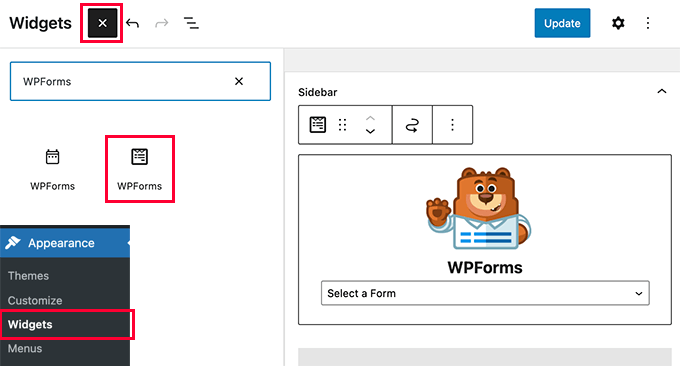
Select the custom login form you just created from the dropdown menu, and then click on the ‘Update’ button to store your widget settings.
You can now visit your website to see your custom login form in action.
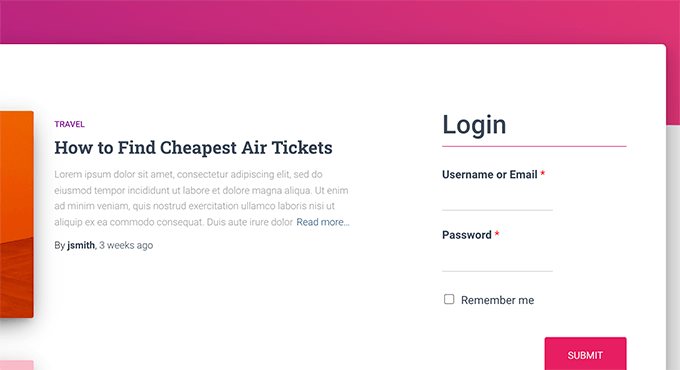
For more on this topic, see our guide on how to create a custom login page for WordPress.
Method 3: Create a Custom Login Page Using SeedProd
If you use WPForms alone to create a custom login page, then the design of your login page will still depend on your WordPress theme.
What if you wanted to design a custom login page that looks more professional and sleek?
SeedProd allows you to easily create a beautiful custom login page for your website.
It is the most powerful WordPress page builder on the market. You can use it to create any type of page without writing any code or learning any special design skills.
First, you need to install and activate the SeedProd plugin. For more details, see our step-by-step guide on how to install a WordPress plugin.
Upon activation, you’ll be asked to enter your license key. You can find this information in your account on the SeedProd website.

Next, visit the SeedProd » Landing Pages screen from the WordPress admin sidebar.
Once you are there, click on the ‘Set up a Login Page’ button.
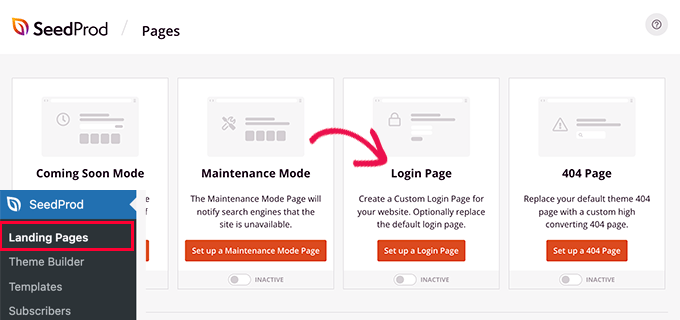
Next, you will be asked to choose a template for your login page.
SeedProd comes with several professionally designed templates to choose from, or you can also start with a blank canvas.
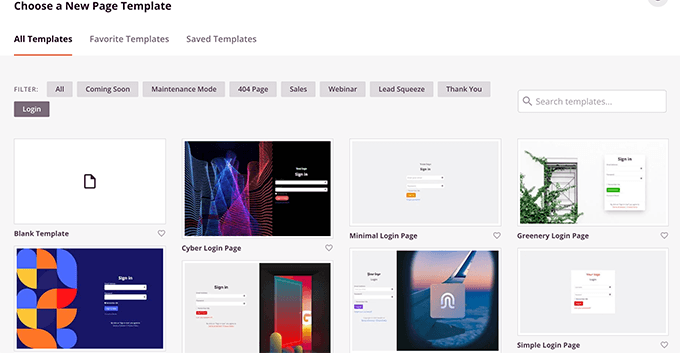
After that, you will have to provide a name and URL for your custom login page.
Then click on the ‘Save and Start Editing’ button to continue.
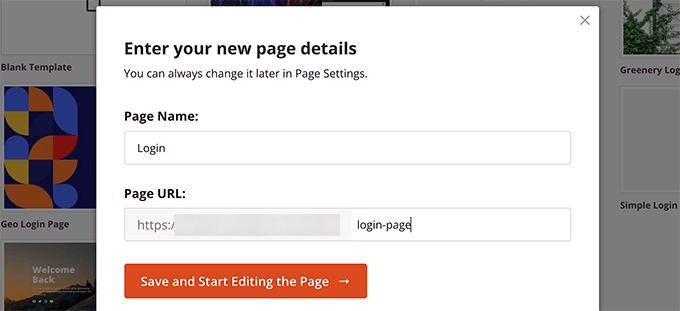
This will launch SeedProd’s page builder interface on your screen.
Here, you’ll see a live preview of your login page where you can point and click to edit any item.
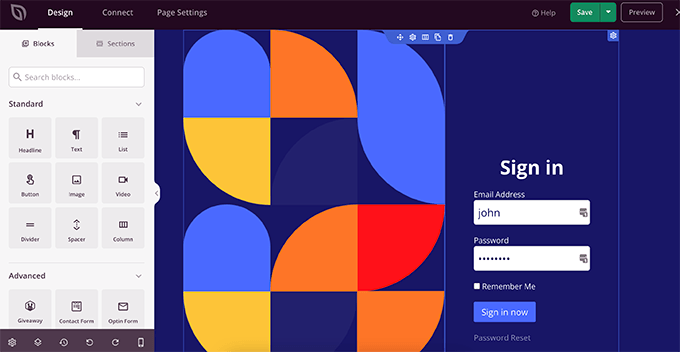
You can also add new blocks to your login page from the left column.
Once you are satisfied with the design, switch to the ‘Page Settings’ tab.
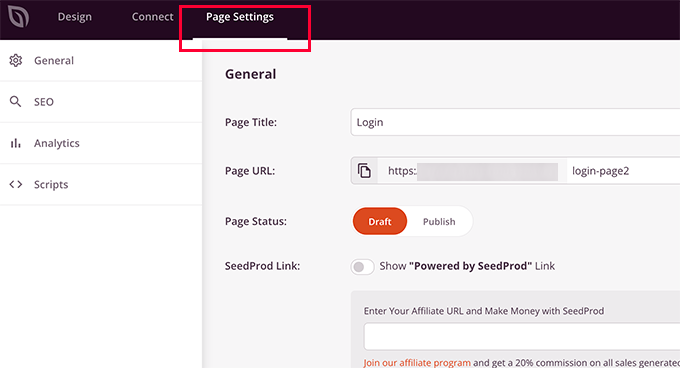
From here, you can redirect users from the default WordPress login page to your custom login page. You can also run your login page on isolation mode, which disables any WordPress header and footer scripts from loading.
Once you are satisfied with your changes, you can simply click on the ‘Save’ button and ‘Publish’ your login page.
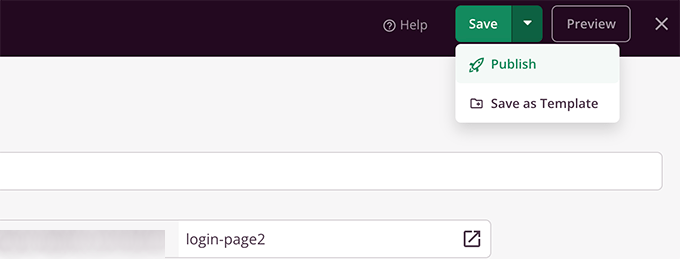
You can now open a new browser tab in the Incognito mode and visit your login page to see it in action.
For more details, see our ultimate guide on how to create a custom login page in WordPress.

Bonus: Managing Users in WordPress
You can view all registered users on your website by clicking on the Users menu tab in the WordPress admin dashboard.
WordPress will show you a list of users with their usernames, names, roles, and email addresses.
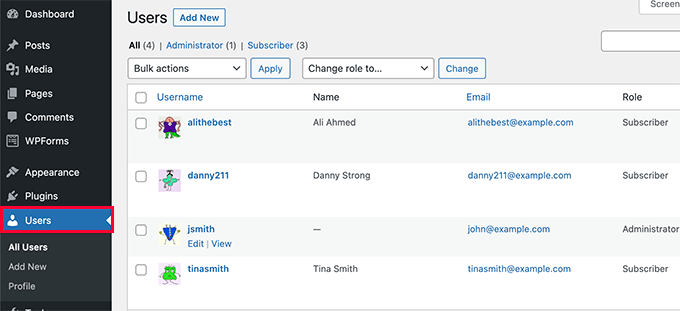
As an administrator, you can delete any user at any time you want.
You can also edit user profiles, change their roles, and even change their passwords. This gives you full control over what users can or cannot do on your WordPress site.
For more information, you may like to see our beginner’s guide on how to add or remove capabilities to user roles in WordPress.
We hope this article helped you learn how to allow user registration on your WordPress site. You may also want to learn how to display WordPress form entries on your site or see our expert picks for the best plugins to efficiently manage multi-author blogs.
If you liked this article, then please subscribe to our YouTube Channel for WordPress video tutorials. You can also find us on Twitter and Facebook.





Mrteesurez
Weldone,
If I use Seedprod for the login page, I think I will still need WPForms as the Seedprod plugin is just to design the interface while the real functionalities if the form will be controlled by WPForms.
Am I right ?
WPBeginner Support
No, you would only need one of those two plugins to have a working custom registration page.
Admin
Mrteesurez
Wow, do you mean Seedprod as page builder can do it alone ?. I thought it’s only for design purpose and just for layout.
Ok thanks for the reply.
Anna
This is awesome – thank you!
Newbie here and I would like to create one registration form for users and that would allow them to be registered in several plugins, so they don’t have to register multiple times for each plugin. What is the best way as Admin to accomplish this?
WPBeginner Support
If you mean several websites then we do have a guide you could follow below:
https://www.wpbeginner.com/plugins/how-to-share-users-and-logins-between-multiple-wordpress-sites/
If you are selling plugins on your site then it would depend on your payment system.
Admin
Robert Whyte
I want to email readers when I post new on my personal blog.
How do I trigger an automatic email when a post is new or modified (assuming I don’t check the ‘don’t change the modified date’), preferably with a link to the post?
Also, can I send an email on general subject without posting?
WPBeginner Support
For what you’re wanting, we would recommend taking a look at our guide below about how to create a newsletter!
https://www.wpbeginner.com/beginners-guide/how-to-create-an-email-newsletter/
Admin
Peter Van Kleeck
There is no “anyone can register” in my Admin panel under General > Settings. In fact there is no “Membership” section at all. What am I missing?
WPBeginner Support
You may be on WordPress.com instead of WordPress.org in which case we would recommend taking a look at our article below that describes the differences between the two.
https://www.wpbeginner.com/beginners-guide/self-hosted-wordpress-org-vs-free-wordpress-com-infograph/
Admin
Bamidele Omonayin
How can i develop a site that users needs to pay before they sign up
WPBeginner Support
You are thinking of a membership site, we cover how to create that in our guide below:
https://www.wpbeginner.com/wp-tutorials/ultimate-guide-to-creating-a-wordpress-membership-site/
Admin
John
Is there a way to have login access required to access a specific page or set of pages and not the entire site?
WPBeginner Support
For that, you would want to use a membership plugin such as one from our list below:
https://www.wpbeginner.com/plugins/5-best-wordpress-membership-plugins-compared/
Admin
Brandon
Hi, I’ just started using Wordpress 3 days ago to start developing my e-commerce website but my general setting doesn’t include the membership option to enable users to register on my website nor the option to choose the new user default role. I’m wondering if it’s because I’m using the multi-site network. Please help me out I’m lost.
WPBeginner Support
If you are using multisite then you would need to go to your network admin site and allow registrations in the settings for that site to allow your subsites to accept registrations.
Admin
Esme
Hi there,
There is no ‘Membership’ section in my WP Settings. Have these settings been moved since this article was written?
WPBeginner Support
If you are on WordPress.com instead of WordPress.org it would be the most common reason, you can see our guide on WordPress.com vs WordPress.org below:
https://www.wpbeginner.com/beginners-guide/self-hosted-wordpress-org-vs-free-wordpress-com-infograph/
Admin
Norma
Hello. What if you don’t want people to register on your website, but rather you assign a username and password and then they just go on to log in? Can that be done?
WPBeginner Support
You can do that and manually create users for each person in which case you do not need to enable user registration.
Admin
Norma
Is there an addon to upload a csv list with 5000 usernames and passwords?
WPBeginner Support
You would want to take a look at the plugin in our article below for importing users:
https://www.wpbeginner.com/plugins/how-to-easily-import-and-export-wordpress-users
Karen
My son runs the school newspaper and wants to set up an online version. The IT staff at his school want to set up a Wordpress site and his head teacher wants to limit the people who can view the paper to pupils only. Is the best way to do this by setting up usernames and passwords as per this article (and only allowing subscribers with a school email address) or is there a better way?
WPBeginner Support
It would be personal preference question on what would be the best method but you can certainly do it that way for one option to limit access.
Admin
Mohammad Ashraf Patel
Hi, I want to force ‘number only’ in username field in new user registration. This is to force the user to enter his mobile number as his username.
Does WPFORMS new user registration have this facility/function?
WPBeginner Support
You would need to use an input mask for what you’re wanting and WPForms would be able to do what you’re wanting.
Admin
David Barker
This tutorial was extremely clear and helpful!
I followed the tutorial for creating a Login WPForms widget. One problem I had was that after the user logged in, they could still see the widget. After a user registers on the User Registration page, then logs in, they can still see the User Registration page. Is there a way to hide pages from users that are logged in?
WPBeginner Support
We do not have a specific recommendation at the moment, we will be sure to keep an eye out for a plugin we would recommend.
Admin
Louise Harris
I work on a WooCommerce site and about 5 or 6 of us in the office use the same admin user account.
We quite often get server errors, 503 I think.
Is this because we’re all using the same user account at the same time?
Thanks!
WPBeginner Support
You would want to try having a user for each person if possible to see if that is the issue.
Admin
Keren Shavit
I use Woocommerce website. If I uncheck “anyone can register”, will people still be able to create an account and buy? people who have purchased show up as “customers” and people who register show up as “subscribers”.
WPBeginner Support
Rather than that, you may want to go under Settings>General and set the default user role to customer. That way any user who signs up to your site by default is a customer
Admin
Dee
Hi,
Is there any way by which the user automatically gets added to subscription list when he posts a comment on any post with their email id?
WPBeginner Support
You are required to make that an option rather than automatic to comply with laws like GDPR
Admin
Lucho
Hi, just something I am doing some research and didnt find any solution yet. Many plugins offers the ADMIN APPROVAL feature for new users registration. Is there a way to allow EDITORs to approve? The reason why is to keep the admin profile to the developers, no one else.
Thanks in advande!
Best,
Lucho.-
WPBeginner Support
You could change user permissions for your editors using the method from our guide here:
https://www.wpbeginner.com/beginners-guide/wordpress-user-roles-and-permissions/
Admin
Rick
Hello,
Can you have the details page, edit details, edit password, logout on a post page?
WPBeginner Support
We do not have a recommended method for placing that on the front end of your site at the moment.
Admin
Minerva
The tutorial is a great help. Very imprtessive! HOWEVER, the way the steps are decribed goes extremely fast. I have to keep replaying five times, at least, to be able to get one instruction then move on… then replay again… then move in 3 seconds, then replay again… Extremely fast. I wish you could speak even just 20 percent slower. Thank you
WPBeginner Support
Thank you for your feedback on our video, you should have the option using the cog in the bottom right of the video to change the playback speed
Admin
Vince Weeks
I want to allow users to register on my site. When I follow the tutorial, it tells me to go to wp admin – settings – general – membership and select allow anyone. I don’t see this option. What now?
WPBeginner Support
You may want to ensure you are an admin of your site and that you are actually in the wp-admin area of your site.
Admin